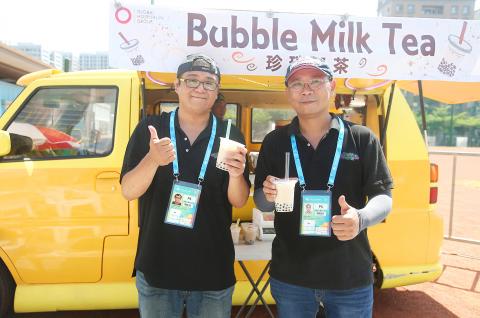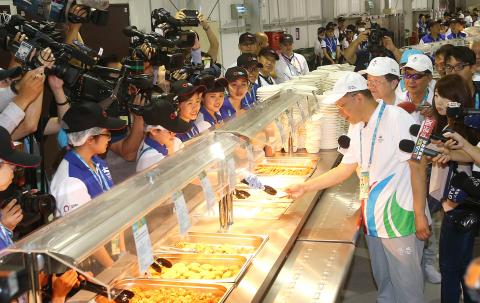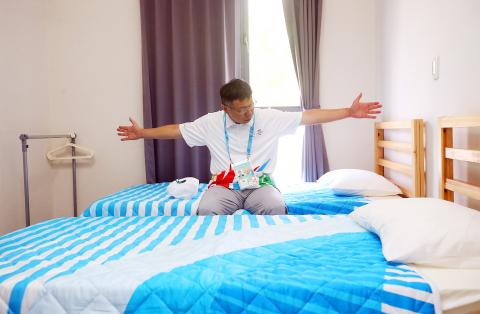The Summer Universiade Athletes’ Village in New Taipei City’s Linkou District (林口) was officially opened yesterday.
Taipei Mayor Ko Wen-je (柯文哲), International University Sports Federation president Oleg Matytsin, Taipei Universiade Organizing Committee chief executive officer Su Li-chiung (蘇麗瓊) and Athletes’ Village director Chiang Han-sun (江漢聲) attended the opening ceremony yesterday afternoon.
“Taipei is now ready to welcome the world with the best of our hospitality,” Ko said in his speech.

Photo: CNA
The village includes 34 buildings, each 12 stories to 21 stories high. Athletes’ accommodation ranging from one to four-bedroom units occupies 23 of the buildings, each of which has a rest area, a service counter and a medical room.
The village has a cafeteria that can seat up to 3,500 people, is to run 20 hours per day and should serve an estimated 35,000 to 40,000 meals daily featuring different cuisines from around the world.
Commercial services, such as dry cleaners, beauty salons, flower shops, banks, a post office and an official souvenir shop are also included.

Photo: CNA
A central security command center has been set up in the village and more than 500 officers have been stationed there, Taipei Special Police Corps deputy chief Lin Chun-yi (林浚奕) said, adding that they are to conduct patrols around the clock to keep the athletes safe.
A 3m-high fence around the perimeter of the village is to channel all people entering and leaving the area through restricted checkpoints at designated entrances, Lin said.
To enter the village, athletes must wear their identification badges, which are to be checked by card readers, he said, adding that their belongings are to also be checked by an X-ray machine.

Photo: CNA
Athletes must also pass through a metal detector door and may be scanned with a handheld metal detector if necessary, Lin said.
Any cars entering the village are to be checked with metal detectors and under-vehicle explosive scanners, he added.
During Ko’s visit, he lay down on a bed in a three-bedroom unit to test its comfort level, drank a cup of bubble milk tea and ate a few Taiwanese snacks from the cafeteria.
The bedroom unit was nice, especially the air-conditioning, Ko said, adding that he thinks the scale and quality of the village, especially the cafeteria, were better than the village in South Korea’s Gwangju he had visited.
Responding to questions about not being able to play the national anthem or raise the national flag during the opening ceremony, he said: “The city government has done the best it could, but the [Chinese Taipei Universiade] flag and the [national flag] anthem were registered with the application to hold the games.”
The city government must conform to the Agreement Between the International Olympic Committee, Lausanne and the Chinese Taipei Olympic Committee, Taipei, Ko said.
Responding to questions about why he said “Taiwan” rather than “Chinese Taipei” in his opening speech yesterday, Ko said: “We are Taiwan. Otherwise, who are we?”
The Summer Universiade is to be held from Saturday to Aug. 30. More than 7,639 athletes are expected to compete.
Additional reporting by CNA

US climber Alex Honnold is to attempt to scale Taipei 101 without a rope and harness in a live Netflix special on Jan. 24, the streaming platform announced on Wednesday. Accounting for the time difference, the two-hour broadcast of Honnold’s climb, called Skyscraper Live, is to air on Jan. 23 in the US, Netflix said in a statement. Honnold, 40, was the first person ever to free solo climb the 900m El Capitan rock formation in Yosemite National Park — a feat that was recorded and later made into the 2018 documentary film Free Solo. Netflix previewed Skyscraper Live in October, after videos

Starting on Jan. 1, YouBike riders must have insurance to use the service, and a six-month trial of NT$5 coupons under certain conditions would be implemented to balance bike shortages, a joint statement from transportation departments across Taipei, New Taipei City and Taoyuan announced yesterday. The rental bike system operator said that coupons would be offered to riders to rent bikes from full stations, for riders who take out an electric-assisted bike from a full station, and for riders who return a bike to an empty station. All riders with YouBike accounts are automatically eligible for the program, and each membership account

NUMBERS IMBALANCE: More than 4 million Taiwanese have visited China this year, while only about half a million Chinese have visited here Beijing has yet to respond to Taiwan’s requests for negotiation over matters related to the recovery of cross-strait tourism, the Tourism Administration said yesterday. Taiwan’s tourism authority issued the statement after Chinese-language daily the China Times reported yesterday that the government’s policy of banning group tours to China does not stop Taiwanese from visiting the country. As of October, more than 4.2 million had traveled to China this year, exceeding last year. Beijing estimated the number of Taiwanese tourists in China could reach 4.5 million this year. By contrast, only 500,000 Chinese tourists are expected in Taiwan, the report said. The report

Temperatures are forecast to drop steadily as a continental cold air mass moves across Taiwan, with some areas also likely to see heavy rainfall, the Central Weather Administration (CWA) said. From today through early tomorrow, a cold air mass would keep temperatures low across central and northern Taiwan, and the eastern half of Taiwan proper, with isolated brief showers forecast along Keelung’s north coast, Taipei and New Taipei City’s mountainous areas and eastern Taiwan, it said. Lows of 11°C to 15°C are forecast in central and northern Taiwan, Yilan County, and the outlying Kinmen and Lienchiang (Matsu) counties, and 14°C to 17°C